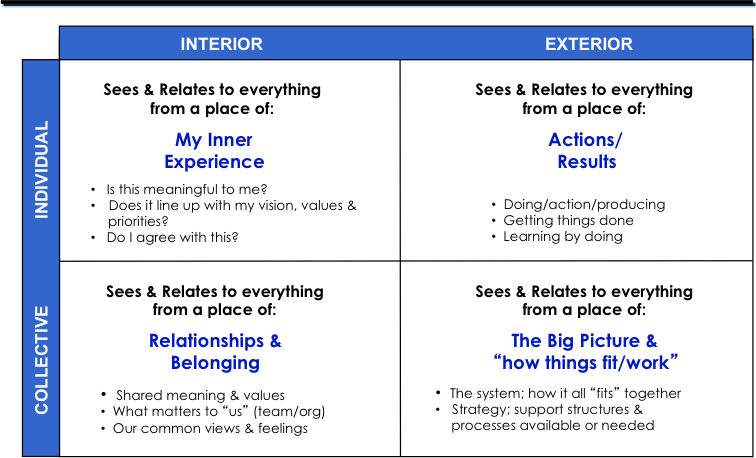In our executive coaching work we help leaders understand their Current Way of Leading and support them adopt a New Way of Leading that is more effective in accomplishing their goals and achieving the breakthrough they seek.
A. Relevance to Leadership
Fundamentally, it’s about realizing you greatest leadership potential. Knowing a leader’s natural orientation helps understand his/her meaning-making system (i.e., how one tends to make meaning of things). One subset of this meaning-making system is how an individual “sees and relates” to other people and situations. Individuals typically have a ‘primary’ and many times a ‘secondary’ orientation (i.e., the “go-to” or “default” perspective(s) they “see through” in order to relate to people and situations); this shapes and helps define their priorities and preferences, what motivates and inspires them, etc. Relationally, it is important to not only know one’s own Leadership Orientation but also being able to discern the orientation of others (e.g., colleagues, team members) so as to be able to respond to situations and/or engage with others in a way that leverages opportunities to engage and inspire others towards desired outcomes.
B. Our Integral Leadership Framework
See Figure 1. Our Integral Leadership Framework, based on Ken Wilber’s Integral Theory, captures four key perspectives an individual tends to “see through” in order to make sense of things. The four perspectives are described by:
a) Interior – Exterior Plane: The Interior realm is subjective in that it cannot be directly measured; it relates to inner ‘knowing’, experience, values, feelings, etc. — captured by the Upper Left and Lower Left Quadrants. The Exterior realm is all that can be observed/measured and includes actions, performance outcomes and other observable data – captured by the Upper Right and Lower Right Quadrants.
b) Individual – Collective Plane: The Individual realm is experienced or observed individually (e.g., that which “I” feel, “I” value, “my” priorities; my actions and performance outcomes, etc. – captured by the Top Quadrants; the Collective realm refers to two or more individuals and systems, including your work team, your organization, community, society, etc. – captured by the Lower Quadrants. For instance, the culture of your organization is captured in the Lower Left Quadrant while it’s strategy, systems and processes are captured in the Lower Right Quadrant.
Figure 1 – Integral Leadership Framework

C. The Quadrants Explained
Upper Left (UL) Quadrant – “My Inner Experience”
Individuals who typically see and relate to things from an “Inner Experience” perspective tend to prefer engaging in initiatives that are meaningful to them in some way; they tend to thrive when there is a sense of fit or alignment with one’s own value, priorities and needs. Typical focus/attitude is “Is this meaningful to me?” and “Does this align with my priorities and needs?” At work, they are likely to buy-into and whole-heartedly engage in a new project or initiative when they see a clear sense of purpose in it and feel an affinity for it.
Upper Right (UR) Quadrant – “Actions/Results”
Individuals who typically see and relate to things from an “Actions/Results” perspective tend to prefer engaging in initiatives that have clear direction, roles, performance expectations and timelines and that tasks are readily actionable. Strong ‘doers’, their typical attitude is that “actions speak louder than words” so “let’s get to it” and there is a strong priority placed on accomplishing things. They are comfortable letting “experience be the teacher”. At work, they are likely to buy-into and whole-heartedly engage in a new project or initiative when their role and accountabilities are clear.
Lower Left (LL) Quadrant – “Relationships & Belonging”
Individuals who typically see and relate to things from a “Relational” perspective tend to prefer taking the time necessary to engage with the whole team to understand their perspectives and feel that there is a sense of shared meaning and value. Typical focus/attitude is “Are we all on the same page?” and “the power of WE”. At work, they are likely to buy-into and whole-heartedly engage in a new project or initiative when they feel that everyone is on the same page and that any impact on others has been considered and mitigated.
Lower Right (LR) Quadrant – “The Big Picture”
Individuals who typically see and relate to things from a “Big Picture/Functional Fit” perspective tend to want to be clear about how things fit or flow together; goals, strategy and plans need to be understood and/or worked on as well as how the pieces fit together (i.e., supportive structures, systems and processes). Typical focus/attitude is on “How does this align with our organization’s goals and direction”? and “Do we have the right support mechanisms?” At work, they are likely to buy-into and whole-heartedly engage in a new project or initiative when they feel that there is clear direction in place and the right support structures and plans have been considered and are being (will be) addressed.
Fundamentally,
• Most people favour and see through primarily one or two perspective(s) at the exclusion of the others (i.e., their blind spots) which not only limits potential success but it can also lead to unintended negative consequences.
• Including and engaging in ALL perspectives provides the best chance at realizing your greatest leadership potential.
Contact Us:
For further information or to have a free consultation about your leadership development needs, please feel free to contact us: https://www.businessintegral.com/contact
_________________________________________________________________________________
Resources
• The Integral Leadership & Management Framework by Dr. Ron Cacioppe
(https://www.businessintegral.com/approach/integral-leadership-management-framework/)
• Wilber, Ken (1996): A Brief History of Everything
• Our Approach – The Integral Model: (https://www.businessintegral.com/approach/the-integral-model/)
• Why Become A Mindful Leader?
(https://www.businessintegral.com/why-become-a-mindful-executive/)
• Conscious Leadership: What is it and why should you care?
(https://www.businessintegral.com/conscious-leadership-what-is-it-why-should-you-care/)
• Feel free to peruse our selected list of articles, books and videos in our Resources tab here:
(https://www.businessintegral.com/resources/)

 Founder and President of
Founder and President of